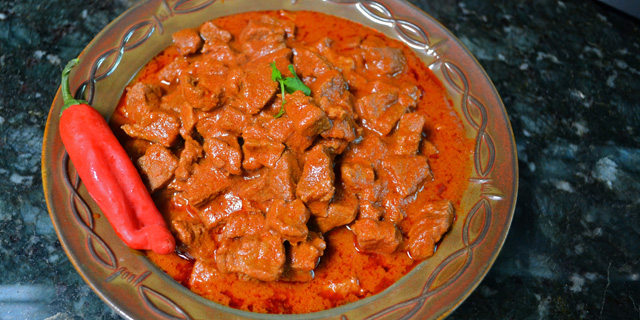I recently spoke with a Mexican-American chef who believes she has flour running through her veins from the amount of time she spent in her parents’ panaderia as a child. I feel the same way about the red chile served at my father’s Mexican restaurant, Ricardo’s. Though it closed years ago, the red chile it once served still pumps through my heart in sanguine rivers, revitalizing my soul with its sweat-inducing, savory gravy. It nourishes me; it’s a part of me.
If my blood is the red chile of my youth, then my muscles are made of lamb. Lamb mixed with rice and mint and allspice, the base of many classic Lebanese dishes. No one can make these dishes like my mother can; authentic in a way that even my Aunt Gaga, hard to please, serves herself seconds.
I’m a Lebican, a term I use to describe a person of Mexican and Lebanese descent. Growing up, I identified with both culinary traditions in equal measure, always wanting to help stuff grape leaves with my mom and Lebanese aunts, or watch the tortilla ladies sling tortillas de harina y maiz onto a hot griddle at Ricardo’s.
Much to our dismay, my brother and I never got Happy Meals or fish sticks. Instead, we were force-fed koosa and tamales, tabouli and salsa picante. We never brought a fruit salad or casserole to neighborhood potlucks, we brought kibbe (a Lebanese dish of ground lamb and pine nuts) or crocks of chile guisado, or stew. Our lunch boxes were full of leftover dolma and little bean burros. Now, as an adult, I could not be more thrilled my parents exposed us to real food, heritage food, prepared with love and family and tradition.
But whose tradition is it? My Mexican mother can’t cook Mexican food and my Lebanese father can’t cook Lebanese food! My father learned how to cook Mexican food when he took over the family business in the 1970’s. There, he served his mother’s Mexican food. My grandmother, a first-generation Lebanese American who immigrated to Arizona, learned to cook things like enchiladas and frijoles from Mexican immigrant workers who worked in the local mines and taught my Mexican mother Lebanese recipes. A jumbled culinary heritage, but one that is uniquely mine.
While I love a homecoming filled with all of my favorite childhood dishes, I recently realized that I didn’t actually know how to make red chile the way Grandma Minnie did, and though the taste of Aunt Gaga’s grape leaves is never far from my tongue, I don’t have the family recipe. When I mentioned this, both of my parents obliged me with private cooking lessons – grape leaves (dolma) and koosa with my mother, and red and green chile guisados, or stews, with my father. I’m now passing those recipes down to you.
Though Mexico and Lebanon may be 7,500 miles apart geographically, in my heart and in my kitchen they are always side-by-side.

- 1 dozen zucchini squash, about 6 inches long each
- 2 cloves minced garlic
- 2 tablespoons lemon juice
- 1 tablespoon fresh mint minced or ½ teaspoon dried mint
- 1/2 teaspoon salt
For the Labneh:
- 1 large cucumber
- 1 clove garlic
- 1/2 teaspoon salt
- 2 tablespoons fresh mint minced or 1 tablespoon dried mint
- 1 pint plain yogurt or labneh
Get the full recipe and ingredient list.
- 1/2 cup lard
- 1/2 cup flour
- 3 pounds beef or pork tenderloin
- 1 Spanish onion, diced
- 2 teaspoons salt
- 1 1/2 tablespoons garlic powder
- 1 1/2 teaspoons black pepper
- 2 cups beef broth
- 1 32 ounce can green chiles
- 1/2 15 ounce can fired roasted tomatoes
Get the full recipe and ingredient list.
- 1 quart grape leaves
- 3/4 cup rice (Uncle Ben’s Converted is best) cooked according to package instructions and cooled
- 1 1/2 pounds coarsely ground lamb shoulder
- 1 1/2 teaspoons salt
- 1/2 teaspoon pepper
- 1 teaspoon Middle East blend seasoning or allspice
- 2 lamb bones or 2 boney lamb chops
- 2 tablespoons lemon juice
- 1 medium fine diced tomato

- 1 cup plus 2 tablespoons lard
- 1/2 cup flour
- 2 1/2 pounds beef tenderloin
- 1 14 ounce carton Bacas red chile puree
- 1 1/2 tablespoons garlic powder
- 1/2 tablespoon cumin
- 1 teaspoon ground oregano
- 2 teaspoons salt
- beef broth




![Making Mealtime Matter with La Familia: Easy Sofrito [Video]](https://thelatinkitchen.com/wp-content/uploads/2015/10/sofrito-shutterstock__0-500x383.jpg)
![Easy Latin Smoothies: Goji Berry Smoothie [Video]](https://thelatinkitchen.com/wp-content/uploads/2015/12/goji_berry-shutterstock_-500x383.jpg)
















![Fun and Fast Recipes: Fiesta Cabbage Salad [Video]](https://thelatinkitchen.com/wp-content/uploads/2015/11/fiesta_cabbage_slaw-shutterstock_-500x383.jpg)









